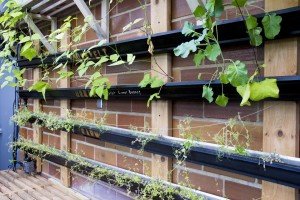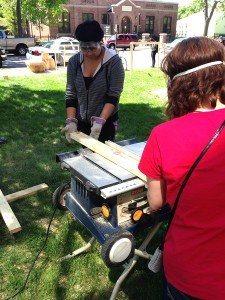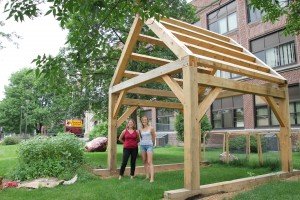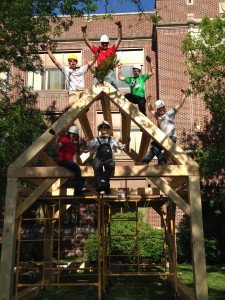Indoor greenhouse renewed, outdoor greenhouse erected, through collaboration with Youth Action Labs (Spark-Y)
By TESHA M. CHRISTENSEN
 Photo left: Students are growing basil, cilantro, broccoli, spinach, radishes, jalapenos, stevia, chard, tomatoes, flax seed and more in the Roosevelt greenhouse. (Photo submitted)
Photo left: Students are growing basil, cilantro, broccoli, spinach, radishes, jalapenos, stevia, chard, tomatoes, flax seed and more in the Roosevelt greenhouse. (Photo submitted)
The greenhouse at Roosevelt is being used to grow vegetables again.
For years, the greenhouse on the south side of the school near the small engine repair classroom was used as a storage room. But last year, with the help of Spark-Y (Youth Action Labs), the space was emptied and the greenhouse reborn.
 A fresh and innovative system was installed, and now students are learning how to grow vegetables via aquaponics.
A fresh and innovative system was installed, and now students are learning how to grow vegetables via aquaponics.
Photo right: Students plant vegetables and spices in the greenhouse on the south side of Roosevelt. The greenhouse was used as a storage room for years before being renewed by the Roosevelt Urban Farm Club (RUF) and the installation of an aquaponics system. (Photo submitted)
A 100-gallon fish tank with tilapia on one side provides the water and organic matter to fertilize the crops. The students grow basil, cilantro, broccoli, spinach, radishes, jalapenos, stevia, chard, tomatoes, flax seed and more.
The enriched liquid circulates throughout the greenhouse.
Students are also becoming familiar with vermiculture bins, and learning how to use worms to add nutrients into the aquaponics system.
 Photo left: Students are gaining construction experience while also putting math and science skills to real-life situations. (Photo submitted)
Photo left: Students are gaining construction experience while also putting math and science skills to real-life situations. (Photo submitted)
Ideas like sustainability, climate change, environmental degradation, economic inequality, job scarcity, and health are investigated by Roosevelt students as they work in the greenhouse. It’s a way to take math, science and construction and connect them with real-world applications.
Katherine Carter’s biology class participated in the project this past school year. Spark-Y also runs the Roosevelt Urban Farm (RUF) after-school club.
Students don’t know where food comes from
Carter has found that her students don’t know where their food comes from. They’re used to seeing it packaged neatly in a grocery store, but don’t know what the plant itself looks like. When shown a picture of a raspberry on a plant, one student’s reaction was one of disgust.
“Students who live in a city don’t know what things look like,” Carter observed.
They don’t know how a seed grows, either. When she took a class for a lap around the Roosevelt building to show them the trees budding out, “the kids were blown away.” They did not know where leaves came from.
Because of the strict standards schools are focusing on, they’re missing out on these basic things in elementary school, according to Carter.
By growing items in the school greenhouse, they get comfortable with the growth system, and it’s not a mystery anymore. But it’s always very exciting.
RUF also focuses on how to grow food in a healthy, pesticide-free manner.
“Rather than not knowing where your food comes from and loading on chemicals to take care of pests, you can grow it in your backyard and know exactly where it came from,” remarked Jessica Bass of Spark-Y.
They’re learning entrepreneurship
 Carter pointed out that she connected many classroom subjects to the work being done in the greenhouse. Energy systems, the food chain, and more were linked.
Carter pointed out that she connected many classroom subjects to the work being done in the greenhouse. Energy systems, the food chain, and more were linked.
Photo right: Roosevelt Biology teacher Katherine Carter and Jessica Bass of Spark-Y are excited by the possibilities of the partnership between Spark-Y and Roosevelt High School. “I think this sets Roosevelt apart,” said Bass. (Photo by Tesha M. Christensen)
After learning that its school budget was being cut, Roosevelt nearly had to eliminate the $15,000 program, but students and community members pushed the school board to find more funding for Roosevelt.
In the future, (perhaps in the spring of 2016), Spark-Y hopes to offer an elective class at Roosevelt that uses the greenhouse to teach about sustainability.
The group is also collaborating with the chef at Busters (4204 S. 28th Ave.). The goal is to provide the restaurant with fresh vegetables and herbs.
Students are not just learning about sustainability and how to raise their own food. They are also learning about business and entrepreneurship, pointed out Carter, who has taught at Roosevelt for the past two years after working in a science lab.
In this way, RUF differs from a gardening club that is merely focused on growing plants. Instead, students are challenged to ask: “How does this matter?”
Spark-Y seeks to empower students, according to Bass, so that they know they can make a difference and change their community. She was hired by Spark-Y after participating in the internship program, as many of its employees are. Spark-Y is an organization at 4432 Chicago Ave. S. run for youth, by youth.
Bass thinks it’s important to let students know that there are other options than working for a big corporation. “I think entrepreneurship is a big thing for my generation,” she observed.
Spark-Y currently partners with five schools and serves approximately 200 youth each year.
Outdoor greenhouse erected on lawn
This spring, the group focused their efforts outdoors.
 They constructed a timber frame greenhouse on the front lawn of Roosevelt using white pine logs sourced from a sustainable forest near Grand Marais.
They constructed a timber frame greenhouse on the front lawn of Roosevelt using white pine logs sourced from a sustainable forest near Grand Marais.
Staff from Spark-Y spent a weekend working with the Timber Framers Guild, cutting all the pieces so that they fit together like a puzzle. There are no nails used at all in the structure. Instead, joints are mortise and tenon.
“It’s a lost art,” observed Bass.
Whereas light frame construction includes many slender sticks of wood simply cut to length and nailed together, a timber frame structure uses fewer, much larger members, shaped at their connections to lock together.
Light frame construction, even when carefully done, is considered rough carpentry, and in dwellings it is always concealed by finished walls and ceilings. Modern timber framework, by contrast, is often exposed, and timbers can be as finely prepared as the skill and care of the craftsman allow.
The whole structure weighed 8,000 pounds. The timber cost $2,500, and the plants, labor and moving it cost $4,000. Both the cost of the outdoor greenhouse and the indoor greenhouse were paid for by grants.
On May 21, participants got out of classes for the day, were treated to a taco lunch, and worked on projects during the RUF year-end celebration.
About 50 students helped put together the greenhouse, build two compost bins and construct a nutrient-dense Hugel gardening bed.
“This will help the whole school not only think about the environment and sustainability but also give kids more opportunities,” observed Carter.
She hopes that many other teachers in various subjects—including art and English—at Roosevelt find a way to incorporate the greenhouse into their lessons.
“I think this sets Roosevelt apart,” stated Bass.
Finding their roots
 Carrine St. Aubin had gardening experience before she joined the RUF after-school club, and it was the idea of an urban farm that drew her to it.
Carrine St. Aubin had gardening experience before she joined the RUF after-school club, and it was the idea of an urban farm that drew her to it.
“It makes people happy and healthy,” remarked St. Aubin, a10th grader at Roosevelt.
Photo left: Carrine St. Aubin is interviewed for a Spark-Y video about the aquaponics system at Roosevelt. Gardening makes people happy and healthy, she said. (Photo submitted)
St. Aubin pointed out that the club appeals to students with a range of interests, from science to business and more. “It’s not just for one type of person,” she said.
She thinks that many people are disconnected from each other because of their screens and believes that RUF is a way to reconnect.
“They can find their roots and get their hands dirty,” St. Aubin said.
Comments
No comments on this item Please log in to comment by clicking here